Working for Louis de Rochemont by Borden Mace, A Portrait |
Read more
at in70mm.com The 70mm Newsletter |
| Written by: Francis Borden Mace, (July 23, 1920 - November 21, 2014) | Date: July 15, 2003 |
First Publicly Projected Movie Ever Made was Shot and Shown in 70mm!!! |
|
 Writer of this article, Borden Mace,
in the white
suit. Picture by Borden Mace Writer of this article, Borden Mace,
in the white
suit. Picture by Borden MaceDespite persistent claims from Great Britain on behalf of R.W. Paul, Germany for Max and Emil Skladanowsky and the USA for Thomas Edison, the generally accepted birthday of the movies is December 28, 1895 when the Lumiere brothers first unveiled their actualites at the Grand Cafe in Paris. The facts, however are not in dispute even though "the names of the men who actually introduced movies to the world (on May 20, 1895) have all but been erased from memory" according to American film critic, Godfrey Cheshire in an important article, "Birth of a Nation. Who really invented motion pictures?" in the Winter 2002 issue of OXFORD AMERICAN, but unfortunately an article not widely read, quoted or appreciated. But of far greater interest to readers of "...in 70mm" is the reported fact that the first public showing of motion pictures anywhere in the world on May 20, 1895 was SHOT in 70mm on May 4, 1895 on the roof of the old Madison Square Garden and later PROJECTED in 70mm at a store-front theater at 135 Broadway on May 20, 1895 on a machine manufactured under the Brooklyn Bridge at 35 Frankfort Street in New York City in late 1894. The intriguing story of a Confederate Army artillery officer named Woodville Latham who taught chemistry at West Virginia University for two decades; his playboy sons, Gray and Otway, who in July 1894 under a franchise from Edison for six peep show machines had opened Lathams' Kinetoscope parlor at 83 Nassau Street in lower Manhattan; a top notch French machinist formerly in the employ of Thomas Edison and "a brillant young British technician named William Kennedy Laurie Dickson" and other team members, makes for fascinating reading. The team's first very, very short experimental film captured the Frenchman's children playing out-of-doors, on the streets, so to speak, while the team leader, Woodville Latham, while smoking his pipe, observed. On April 21,1894 reporters were invited to see the film in the team's workshop under the Brooklyn Bridge. The New York Sun on the very next day carried an illustrated report (A detailed drawing of the projected image from film to screen in The Sun is reproduced in Godfrey Cheshire's article. The article was favorable but also included a long interview with Thomas Edison who said the device was simply a version of his peep show machine and that he would offer a projector with synchronous sound. Publicly challenged by Woodville Latham, Edison failed to produce. The Latham team's invention - projected motion pictures for group viewing was vastly different from Edison's single-viewer Kinetoscope celluloid peep shows, which nevertheless were "the world's first commercial display of moving-picture photography but without the vital capacity for projection." Edison according to Cheshire was "curiously myopic when it came to projecting movies, "convinced that he could make more money from single viewer machines." The British technician Dickson while employed by Edison "to pursue the idea of moving photographs... to give a visual dimension to his most famous invention - the phonograph, had in 1893 created what would be the prototype for all future movie cameras: it incorporated the crucial idea of using sprocket holes to advance the film, a flexible stock created by Eastman Kodak." |
Further
in 70mm reading: "Windjammer" Bob Gaffney "Windjammer" - Exclusive Danish Re-release Internet link: |
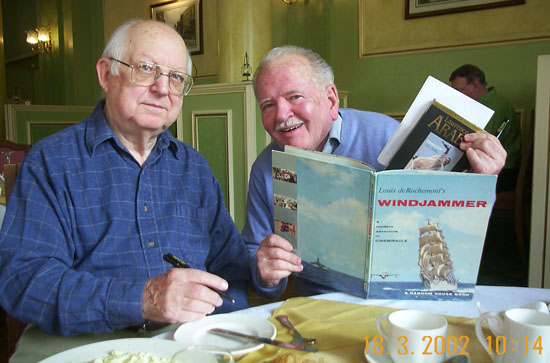 Left to right:
Cinemiracle pioneers Dick Babish (camera)and
Borden Mace (Producer) in Bradford, 2002. Picture by Thomas Hauerslev Left to right:
Cinemiracle pioneers Dick Babish (camera)and
Borden Mace (Producer) in Bradford, 2002. Picture by Thomas HauerslevDickson had also earlier constructed for Edison the world's first movie studio, the tar paper-covered "Black Maria" in West Orange, New Jersey to supply the extremely short film loops for the single viewer Kinetoscope Machines which the Latham brothers quickly franchised while demanding that "Edison's camera and viewer be retooled to almost triple their film capacity." The Latham boys recognized the appeal of the peep shows and wanted to combine it with the popular attraction of prizefighting. On June 15, 1894, the Latham group went to West Orange, New Jersey "to watch Dickson (the world's first movie director) and the Black Maria staff shoot their first film as Edison looked on." The filmed six abbreviated rounds of boxers Leonard and Cushing "made front-page news in New York the next day." One month later the Lathams' Kinetoscope parlor opened at 83 Nassau Street where the six successive rounds could be viewed individually on six separate, newly expanded Kinetoscopes, each viewing costing ten cents: six abbreviated rounds on six different machines for a total viewing time of less than fifteen minutes at a total cost of sixty cents per single-viewer. Being able only to peep at the communal spectacle of boxing was the probable cause of the Latham sons asking their scientist father "to design a machine for projecting pictures upon a screen." Dickson "began secretly moonlighting from West Orange where his ideas for projection had been spurned” and became an important Latham team player. "When his duplicity was discovered, it ended his employment with Edison." By November 1894, Woodville Latham's group "had manufactured a projector". This fascinating revelation that MOVIES STARTED IN 70MM first came to me some six months after Cheshire's article was published in Winter, 2002, while I was procrastinating and occasionally contemplating a long promised piece for Thomas Hauerslev's "...in 70mm" about the career of Louis de Rochemont, Sr., my mentor and friend. |
|
The Career of Louis de Rochemont, Sr., my Mentor and Friend |
|
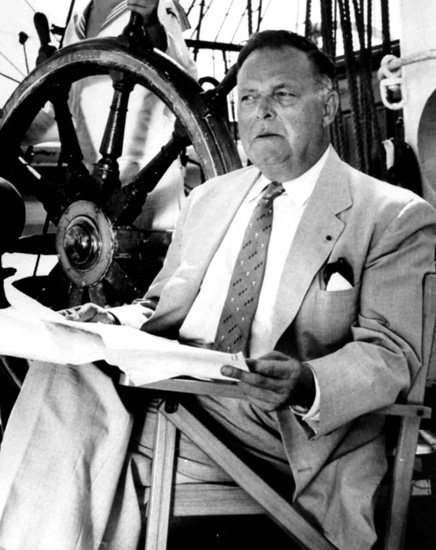 Louis deRochemont on the deck of the Christian Radich.
Picture by Borden Mace Louis deRochemont on the deck of the Christian Radich.
Picture by Borden MaceLouis deRochemont and Louis B Mayer were both born in Chelsie, Mass in the late 1800s; both were motion picture pioneers. deRochemont made his first camera himself from plans printed in Popular Science magazine. In any event, as a high school student he shot 35mm b&w silent film of people in the streets which were later shown in the local cinema with the advertisement; "See yourself on the silver screen. He put you in the pictures." Ironically, it was deRochemont, both a modern movie pioneer, accurately known as a "maverick of the movies, "who took motion pictures out of the Hollywood studios and back onto the streets where they started." He won two Academy Awards: One for "The March of Time", a new type of pictorial journalism, which revolutionized the news reel and one for best feature length documentary, film, "The Fighting Lady", which imaginatively combined aerial combat footage of World War II in the Pacific with some private 16mm film made by aircraft carrier pilots for personal viewing only. The film was blown up to 35mm for release. The film from the 16mm gun cameras mounted in the wings of fighter pilot planes provided the excitement; the private film, the emotion and was the basis for the March of Times. Years later the same excitement was greatly enhanced when deRochemont removed the nose of carrier planes and replaced it with a 70mm camera and a 3-eyed monster for take offs and landings of moving aircraft carriers. The high speed traveling camera was essentially the same effect one was in 16mm, are in 70mm. This technique whether on a ferris wheel, bob sled, basket or flying machine gave you the thrill by putting you in the picture. DeRochemont made three black and white feature films for Twentieth- Century Fox, all outside the studios on real locations, over the objections of Darryl Zanuck, head of Fox productions. All were critically acclaimed and box-office smashes: "The House on 92nd Street" (Henry Hathaway), "13 Rue de Madelaine" starring James Cagney and "Boomerang" starring Dana Andrews (Elia Kazan). The eminent film critic, James Agee (Volume I, AGEE ON FILM, who loved all deRochemont films for their stark realism, clear and sharp, in depth, B&W photography shot on real locations appropriate to compelling true stories, went so far as to say that deRochemont was the one producer whose movies could always be identified as his no matter who directed them - Hathaway, Kazan, Werker, Siodmak, etc. DeRochmont, chaffing under the control imposed by Zanuck and the studio, did the unusual: he engaged the top Hollywood agent, Sam Jafee (Humphrey Bogart, Lauren Bacall, etc.) to get him OUT OF HIS CONTRACT! FOX released deRochemont from a lucrative contract to the studio, "Provided that deRochmont would not say anything derogatory about Zanuck or Twentieth-Century Fox and would agree not to make any feature films for a period of three years. DeRochmont readily agreed, moved back East to his beloved New England and opened shop in New York City to produce in 35mm to ensure quality, a series of 36 short educational films entitled "The World and its People" for an eastern educational subsidiary of Universal Pictures. Thirteen of the world's best documentary filmmakers completed the task of introducing films to very young children realistically but empathically to the children of other cultures. The films were an immediate success even though it took almost five years to earn their cost back through skimpy school budgets and the lack of 16mm projectors in the schools. But in twenty years, they had been responsible for changing what, why and the way we teach "human geography" in schools. Each 15 minute film, with a slight story thread or peg, not only depicted life in a different land but also in an important departure from accepted practice, illustrated a basic geographic concept or truth, such as “Water is essential to life.” This 1 of 36 concepts was the underlying theme of the film on the American Southwest where the waters from the melting snows and the rivers of the Rocky Mountains are routed to the California Desert and to Los Angles where the imported water makes life possible. In Guatemala, as a family boards a little train on the hot Eastern coast and cuts through a huge banana plantation they make sure they have sweaters for the cooler mountain tops where coffee is grown and harvested. The family takes off sweaters as they come down the mountains and approach the West Coast where again bananas seem to be everywhere. From the vicarious experience we learn “That with every change in altitude there is a change in temperature, agriculture, shelter, clothing and way of life.” We are observing life in another land, starting to think scientifically on a higher level and discovering underlying concepts that we will in time articulate as the truth. |
|
 Louis deRochemont and Louis deRochemont III sometimes during
1958. Editors collection. Louis deRochemont and Louis deRochemont III sometimes during
1958. Editors collection.The first film in the series, "Normads of the Jungle", photographed and directed by a former March of Time colleague, Victor Jurgens followed the travels and lives of a Malayan family. It is still in use in early schools as well as at the Yale University Department of Anthropology. This "short subject" was of such artistic quality and general interest that it was also chosen by Universal Pictures to premiere at the Paris Theatre in New York City. It was highly praised for all of the right reasons and opened the way for the best of the series to play theatrically as well as in the classrooms. Everyone who worked on this highly innovative educational series felt richly rewarded. As the only one of the Louis deRochemont Associates, Inc., who had not formerly worked for THE MARCH OF TIME, I was very honored to be asked to serve as president of this and four affiliated companies formed later. After a three years absence from making feature films, Louis deRochemont returned to the silver screen in 1949 with a block-buster, "Lost Boundaries" starring a young Broadway actor of great promise, Mel Ferrer and the legendary Canada Lee. It was independently shot entirely on locations in New England and in Harlem in New York City in the approximate areas where the true story took place. DeRochemont believed that “Realism is the essence of drama”, and fought for authenticity in all of his films. His code however allowed for some poetic or creative license if a basic integrity was maintained. Thus aspects of multiple characters could be combined into one, just as time and places could be condensed, combined or otherwise adjusted to accommodate the special needs of story and film. "Lost Boundaries" was a New England story that in deRochemont’s view demanded to be shot in New England. |
18 July
2003 Just a quick note to advise that I thought Mr. Mace's article was wonderful. I felt I could hear his voice chatting informally, sharing some of his favourite experiences in the great adventure of the movie business. The David Lean anecdote was especially memorable. Regards, B. Baker, New York 18. May 2007 I was very interested by the work that you have done on Louis de Rochemont. I found this site by “googling” my father – Victor Jurgens. He is cited in the website and I am very pleased to see that all the great work that he did with Louis de Rochemont is mentioned in the portrait. A lot of times these things are completely forgotten despite their considerable degree of fame and achievement at the time. Thanks very much! Michele Jurgens |
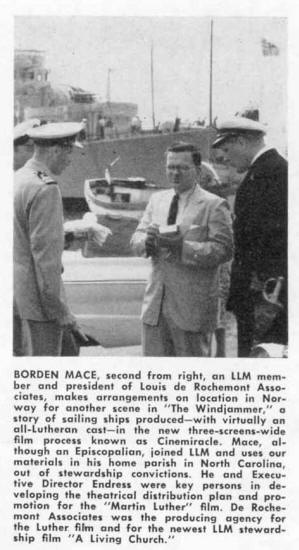 A doctor who was part Negro had been practicing in a New Hampshire town where the question of race never came up or he was considered white if it did. He developed a reputation as a top specialist in the treatment of severe burns. At the beginning of World War II he was recruited by the Navy and commissioned a Commander in its Medical Corp. Naval Intelligence during a routine check discovered that he had been a member of a Negro fraternity while in school at Rush University in Chicago. His family had been brought up as white in a white community but his commission was revoked because the Navy did not commission black officers. A doctor who was part Negro had been practicing in a New Hampshire town where the question of race never came up or he was considered white if it did. He developed a reputation as a top specialist in the treatment of severe burns. At the beginning of World War II he was recruited by the Navy and commissioned a Commander in its Medical Corp. Naval Intelligence during a routine check discovered that he had been a member of a Negro fraternity while in school at Rush University in Chicago. His family had been brought up as white in a white community but his commission was revoked because the Navy did not commission black officers.A group of students from the University of New Hampshire had gathered in the study of the deRochemont family home just outside Portsmouth to discuss race relations and the movies. As the students departed around midnight one who had dropped behind said, I particularly enjoyed the frank discussion tonight because just last week I discovered that my family was black." Louis asked the dark tan young man to stay behind and tell him his story. The next day at the headquarters of the Readers Digest at lunch, Louis told the same story to Mr. and Mrs. DeWitt Wallace who immediately asked William L. White to research and write the story (It became a best selling novel and movie.) On the spot Mr. Wallace suggested a new corporation, The RD-DR Corp, for Readers Digest and DeRochemont which from then forward had a first option for movie rights on all Dramas of Real Life stories originated by the Digest. "Lost Boundaries" was the first feature film to feature blacks as professionals - doctors, lawyers, teachers, etc. Heretofore they had only been seen as servants, comics, soldiers, singers, dancers and musicians and seldom with whites except as servants. One exception was when Bojangles danced with the young Shirley Temple in "The Littlest Rebel". "Lost Boundaries" was a great critical and box-office success. It was also banned in Atlanta and in Memphis as being disrupting to existing mores. RD-DR Corp. appealed the censorship all the way to the Supreme Court of the land, which unfortunately upheld the ban. Many constitutional scholars however consider the briefs prepared by our lawyer, former New York Supreme Court Judge Samuel Rosenman, the basis upon which the U. S. Supreme Court shortly thereafter declared that motion pictures and other modern mass media were entitled to the same freedom of expression as the print medium. It seems only natural that Stanley Warner Theaters asked famed independent producer, Louis deRochemont to create on location with a slight story thread its first Cinerama wide screen film, "Cinerama Holiday" to follow the introductory "This is Cinerama" and that National Theaters would select him to create its first and only Cinemiracle widescreen film, "Windjammer". George Skouras an official of Magna Pictures with Rodgers & Hammerstein called on fellow film pioneer Louis deRochemont to create opening short films with maximum audience participation when research showed him that with all the artistry and glorious music of "Oklahoma!" and "South Pacific" in Todd AO, audiences still wanted the thrill of being in the picture. "Big and Little" Louie made "The Miracle of Todd-AO" (1956) and "The March of Todd-AO" (1958) and moving the Todd-AO cameras they same way they did in Cinerama and Cinemiracle. And box-office receipts went up dramatically. Louis deRochemont was the only producer in the world who made theatrical attractions in the three major surround screen and surround sound processes of his time. |
|
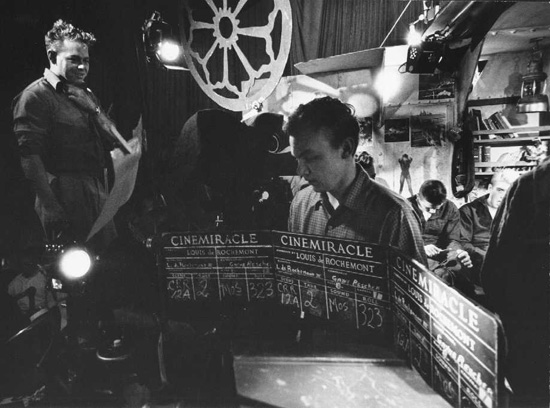 Filming of "Windjammer" in the
Bronx studio. Louis
de Rochemont III is seen far left. Editors collection. Filming of "Windjammer" in the
Bronx studio. Louis
de Rochemont III is seen far left. Editors collection.Before writing this I had planned to, but did not, revisit the indoor tennis court on an estate on Long Island where the first two Cinerams films were assembled, edited and scored, and to revisit National Theatre’s long shuttered Mt. Eden movie palace in the Bronx not far from Yankee Stadium, where we could screen and edit Cinemiracle footage as it arrived “All the Way From Norway,” Madeira, Puerto Rico, the Virgin Islands, Barbados, Miami, New York, Boston, Copenhagen and Oslo. I will never forget the day David Lean called Louie, who was on location at sea, and the call was referred to me at the Mt. Eden. It was his last day in New York and he would like to see some footage in CINEMIRACLE if possible. Normally visitors were not allowed, but David Lean is my all time favorite director. “Come right out. I’ll be at the front entrance under the marquee.” He came and we screened the Madeira sequence including the down-hill basket ride plus a first assemblage of our windjammer, the Christian Radich, crossing the Atlantic. He was very gracious and I think impressed. Our batch of editors had just at the moment finalized the single most important film cut which would be made in the entire film: the cut from the Virgin Islands underwater sequence made by our three eyed camera mounted on the bow of a submarine as it surfaced in a flurry of bubbles to an indistinguishable flurry of bubbles photographed hundreds of miles away on the bow of a submarine as it surfaced to reveal our windjammer under full sail in the middle of a U.S.Navy Fast Carrier Task Force somewhere off the coast of Norfolk, Virginia. To even the most experienced and expert editors, the final footage connecting the two separate shots through millions of air bubbles, appears to have been made in one continuous shot at one point in the vast ocean. To add to the impact as the bubbling water fell from the camera’s lens in a close shot a vast vista suddenly appears in brilliant sunshine with billowing white clouds against baby-blue sky above a cobalt sea upon which sailed our grand lady from Europe being escorted by the United States Navy to the New World. David Lean, as well as the rest of us, who were seeing it together for the first time, were in awe in amazement and joy. Mr. Lean asked to see it a second time. |
|
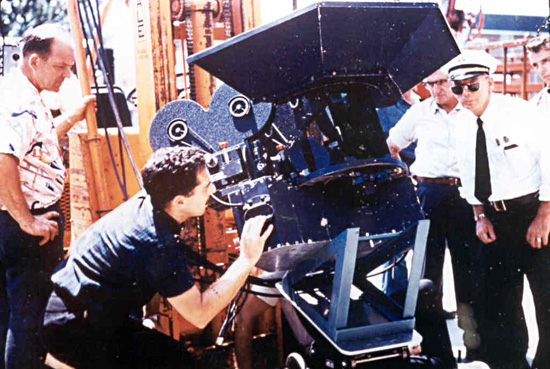 Tom
Conroy working with the Cinemiracle camera. Dick Babish collection Tom
Conroy working with the Cinemiracle camera. Dick Babish collectionRiding back to Manhattan alone with a captive David Lean in a thirty minute taxi ride, I had questions of a lifetime to ask him. I never got to ask one. He was so excited and had so many questions he wanted answers to. He hadn’t commented on “the seam lines” separating “the three screens” until just before he departed. “I think it is much less noticeable than in Cinerama..” Far, far more important however was what he had to say half way back to the City as he looked me straight in my eyes, “That submarine scene emerging from the ocean waters is the single most impressive shot I have ever seen on a motion picture screen.” Whether it was hyperbole of the moment or considered judgment I was overwhelmed to hear it from the master. In my opinion, no director has ever been able to equal the artistry of David Lean in the use of wide-screen photography shooting on authentic locations to tell truly dramatic stories. He probably knew that “our shot” was actually two shots combined but he never asked and I never volunteered to say. I much prefer to cherish the unadorned memory. |
Bob Gaffney about the filming of the
submarine “That submarine scene emerging from the ocean waters is the single most impressive shot I have ever seen on a motion picture screen.” David Lean |
 Today the Latham name is recalled only when we refer to the Latham
Loop for the inventor of the all important loop of film made before it enters
the gate of a camera and projector and once again after it exits. However it is the same Latham who first gave the world projected motion pictures and ...in 70mm, no
less. The intermittent motion of stopping the film in the gate for an instant before the shutter closes, came in 1895, acquired by Edison in 1896 who was allowed to claim the invention as his own by agreeing to pay royalties, according to Cheshire. (Putting the intermittent principle to work brought smoothness, steadiness and greater clarity to the screen.) But as Cheshire reminds us, "Terry Ramsaye, the American cinema's first historian, duly memorialized in the 1920s when he looked back to the medium's birth, ‘The opening (on) May 20, 1895, imperfect and ill advised as it was, was the first public
showing of motion pictures in the world. The pictures flickered and danced
and glimmered. It was only the ghost of a show, but it was first.' " And ….IN 70MM. Today the Latham name is recalled only when we refer to the Latham
Loop for the inventor of the all important loop of film made before it enters
the gate of a camera and projector and once again after it exits. However it is the same Latham who first gave the world projected motion pictures and ...in 70mm, no
less. The intermittent motion of stopping the film in the gate for an instant before the shutter closes, came in 1895, acquired by Edison in 1896 who was allowed to claim the invention as his own by agreeing to pay royalties, according to Cheshire. (Putting the intermittent principle to work brought smoothness, steadiness and greater clarity to the screen.) But as Cheshire reminds us, "Terry Ramsaye, the American cinema's first historian, duly memorialized in the 1920s when he looked back to the medium's birth, ‘The opening (on) May 20, 1895, imperfect and ill advised as it was, was the first public
showing of motion pictures in the world. The pictures flickered and danced
and glimmered. It was only the ghost of a show, but it was first.' " And ….IN 70MM.End. |
|
|
Go: back
- top - back issues
- news index Updated 22-01-25 |
|
